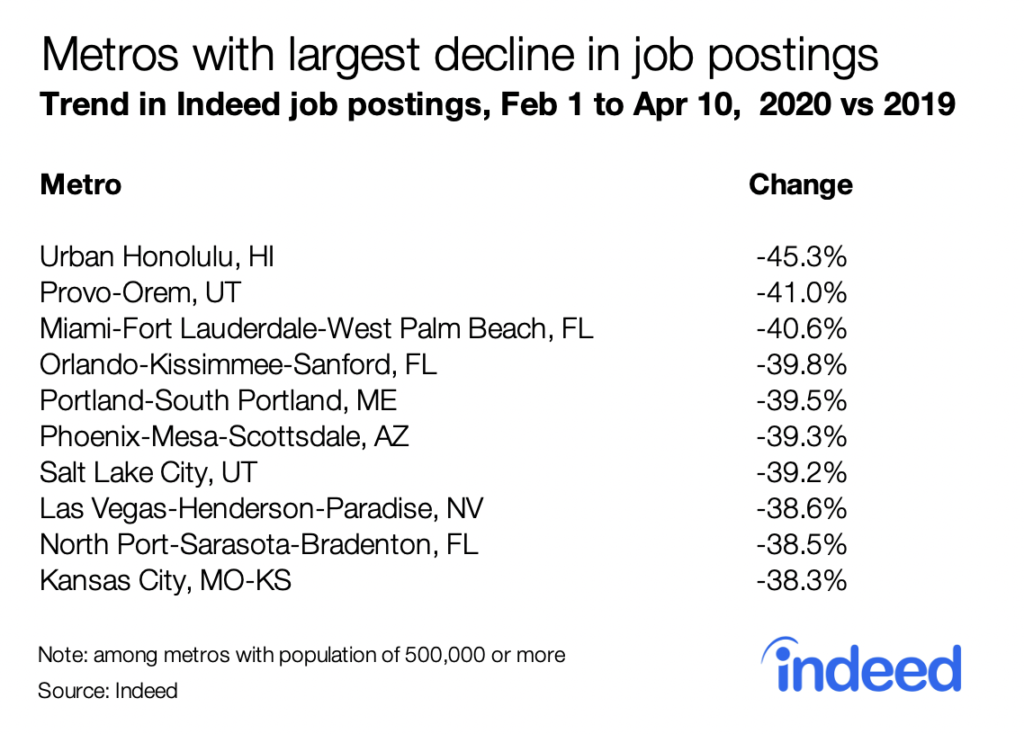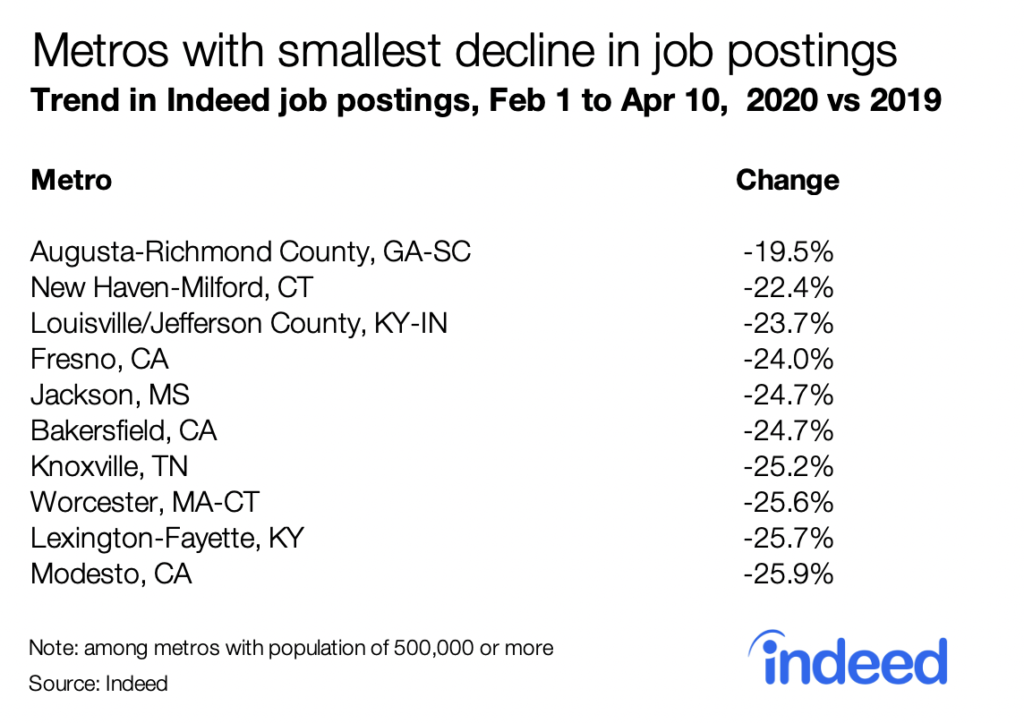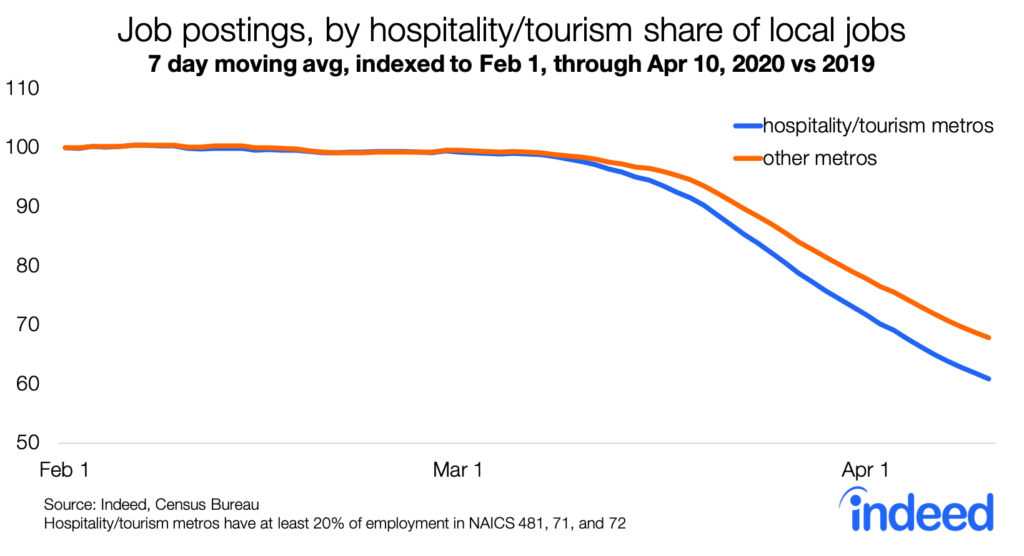Key points:
- The economic pain from COVID19 is widespread. All large metropolitan areas have seen dramatic declines in job postings — including metros where death rates from the virus are low so far.
- Job postings have trended downward most severely in metros most dependent on hospitality and tourism — sectors that have largely shut down in recent weeks.
- The drop in job postings is also steeper in the sorts of places that typically have high COVID19 death rates — larger, denser, colder metros with bigger shares of older and Black residents. Nevertheless, the most extreme COVID19 hotspots have not had unusually sharp declines in job postings.
The economic toll of the COVID19 pandemic is already severe and still perhaps only in its early stages. One sign of the damage: Job postings on Indeed.com, a real-time measure of labor-market health, plunged 31% for the US between Feb. 1 and April 10 relative to the comparable period in 2019.
Within the US, the drop ranges from less than 25% in New Haven, Louisville, and Fresno to more than 40% in Honolulu, Provo UT, and Miami. Leisure and tourism destinations large and small have suffered the largest falls.
In addition, the types of places that tend to have higher COVID19 death rates — larger, denser metros with colder weather and higher shares of African-American and older residents — have also registered larger job posting declines. For example, postings dropped more than the national average in Atlanta, Minneapolis-St. Paul, and Rochester NY — which fit the pattern of places with high death rates, but aren’t actual hotspots. Nevertheless, the hotspots that have suffered very high death rates, including New York, Detroit, and New Orleans, haven’t seen bigger drops in postings.
This suggests that the economic slowdown reflects national and global trends in the progression of the virus and, to some extent, expectations of local risk from the disease, rather than reactions to actual death rates in particular localities. The bottom line: Although the pandemic has hotspots and some places have suffered extreme death rates, the economic crisis is spread more evenly.
The metros with the steepest and gentlest declines
The labor market has slowed dramatically throughout the US. Among all 107 metros with half a million or more people, the smallest job posting decline was 19% in metro Augusta GA — an enormous drop by any reckoning.
Honolulu, Provo UT, and Miami had the largest posting declines among the 107 large metros. Hawaii and Vermont are the states with the steepest posting drops, while most of the metros with the biggest fall-offs are in Florida and the Southwest.

In addition to Augusta GA, five other metros have seen the trend in job postings fall by less than a quarter: New Haven CT, Louisville KY, Fresno CA, Jackson MS, and Bakersfield CA.

Strikingly, despite big local variation in deaths, differences in job posting trends are fairly small. Of the 107 large metros, the 10th-smallest decline is 26% and the 10th-largest decline is 38%. Compare this with the enormous variation in death rates: Among these same metros, the 10th-highest rate of COVID19 deaths per million population is 24 times higher than the 10th-lowest rate. The pandemic has hotspots, with some places suffering severely and others — for now at least — escaping the worst. By contrast, the economic crisis is spread more evenly.
Hospitality and tourism markets saw larger drops
The COVID19 pandemic has nearly shut down the US hospitality sector. Nationally, hospitality and tourism job postings are down 63%, twice the drop for jobs overall. The metros with the biggest declines are those where hospitality and tourism drive the local economy. Among large metros, Las Vegas, Orlando, and Honolulu have the highest share of employment in accommodation, food service, air travel, and related hospitality and tourism industries — and these places have had among the biggest job posting drops.
Among smaller metros too job postings are down most in vacation spots. The trend in postings is off more than 40% in ski towns like Breckenridge and Steamboat Springs CO, and Summit Park UT; the island getaways of Kauai, Maui, and Key West; and entertainment destinations like Atlantic City NJ and Branson MO.

Pandemic hotspots aren’t economic hotspots
COVID19 hasn’t struck randomly. Death rates have been systematically higher in more populous, denser, colder places, and those with higher shares of residents who are Black or older than 60. And there are indications that people in such metros are more concerned about COVID19. For example, residents there tend to practice physical distancing more, according to mobile-device tracking data.
Notably, metros at greater risk from COVID19 based on density, demographics, and weather patterns have also registered bigger job posting declines. In other words, the economy has slowed more in places that seem to be at greater risk based on national patterns, even if they aren’t current virus hotspots — metros like Atlanta, Minneapolis-St. Paul, and Rochester NY.
But the relationship between local pandemic severity and local economic crisis breaks down at the extremes. In each of the four large metros with the highest death rates as of April 10 — New York, New Orleans, Detroit, and Fairfield County CT — the trend in job postings was down 31-32%, right near the national average. Similarly, in the mid-size metros with the highest death rates, Flint MI and Shreveport LA, job postings have declined only at the national average or even less.
In short, the nation’s current COVID19 hotspots haven’t had unusually large job posting drops. The point is more subtle. While the hottest spots haven’t fared worse, places at greater risk based on the general national pattern of virus death rates — those metros that may be big, dense, or cold, and have large senior or African-American populations — have registered larger declines. This suggests that the economic slowdown is more a reflection of national and global trends, and perhaps of expectations about the future locally, rather than a reaction to current local pandemic severity.
Methodology
To measure the trends in job postings, we calculated the seven-day moving average of the number of job postings on Indeed for the US overall and for each metropolitan area. We index each day’s seven-day moving average to the start of that year (Feb 1, 2020 = 100 for 2020 data, and so on). We report how the trend in job postings this year differs from last year in order to focus on the recent changes in labor market conditions caused by COVID-19. More detail is available in the note to this post. Military job postings are excluded. Information based on publicly available information on the Indeed US website, limited to the US, is not a projection of future events and includes both paid and unpaid job solicitations.
Death rates are from daily counts of COVID19 cases and deaths compiled and reported by the New York Times based on reports from state and local health agencies.
The analysis is based on a population-weighted metro-level regression of the trend in job postings on (1) share of jobs in the hospitality sector; (2) predicted death rate per capita from a separate regression; (3) the residual from the predicted-death-rate regression; (4) the previous trend in employment 2016-2019 as a control. In the deaths-per-capita regression, explanatory variables included density, population size, March 2020 temperature and precipitation, and share of residents with college degrees, or who are age 60 or more, African-American, Hispanic, or Asian.
Data sources: Census Bureau (population, density, age, and race and ethnicity); County Business Patterns (share of hospitality and tourism jobs — NAICS 481, 71, and 72); National Oceanic and Atmospheric Administration (temperature and precipitation); Bureau of Labor Statistics (employment growth 2016-2019); and the GeoDS Lab of the University of Wisconsin at Madison (physical distancing measures).






